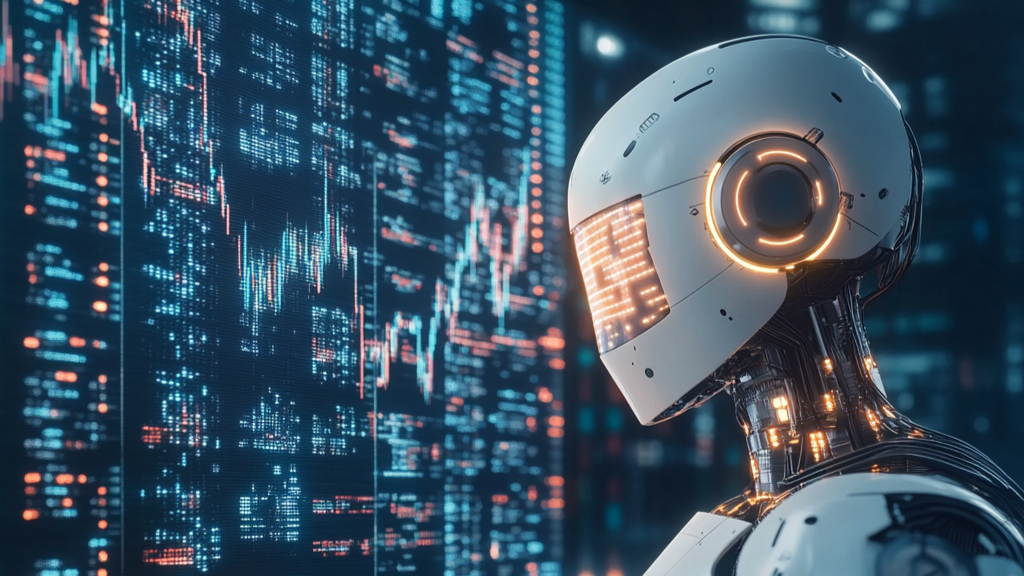How to Use AI in Forex Trading: A Beginner’s Guide
In today’s fast-moving currency markets, AI is quickly becoming a key ally for traders – especially beginners. While experienced traders may rely on intuition and years of screen time, newcomers often face steep learning curves, emotional decisions, and overwhelming data. That’s where artificial intelligence steps in.
Rather than automating trades blindly, modern AI tools support smarter decisions through data-driven analysis. From spotting trends on EUR/USD charts to evaluating how economic news affects sentiment, AI helps simplify the complex. It reduces guesswork, highlights high-probability setups, and delivers insights that would take a human hours to uncover – all in real time.
This beginner’s guide explains how to use AI in forex trading to make informed choices, avoid common pitfalls, and start building confidence in your trades. Whether you’re just learning what forex is or already testing strategies, this article will help you take the next step with AI-powered tools, without needing to write a single line of code.

How AI Transforms Forex Trading for Beginners
For those just stepping into the world of forex, the sheer volume of market data, news, and volatility can feel overwhelming. This is where AI steps in as both guide and assistant – helping traders make sense of what’s happening and why. At its core, AI forex trading is about transforming scattered data into structured insights that beginners can act on confidently.
One of the most useful applications of AI in forex trading is the generation of ai forex signals. These signals are based on real-time analysis of multiple factors: price movements, volatility, historical behavior, and macroeconomic indicators. For example, an AI system can analyze patterns in the EUR/USD pair and suggest a buy signal if certain momentum and sentiment thresholds are met. Unlike manual signals, which are prone to delay and human error, AI signals are faster and more consistent.
Another way AI supports beginners is by filtering noise. Forex markets react to everything – interest rates, employment data, geopolitical tensions – and it’s easy to get lost in contradictory headlines. But with natural language processing (NLP), AI tools can scan and interpret hundreds of news articles, tweets, and financial reports in seconds. Instead of reacting emotionally, traders get a clear picture of market sentiment and how it might affect specific currency pairs.
For those asking how to use AI in forex trading, the key lies in seeing AI as a decision support system. It won’t guarantee profits, but it dramatically increases the quality and speed of analysis. For a beginner, this means spending less time second-guessing and more time understanding the mechanics of the market – supported by reliable, data-driven insights.
Step 1 – Use AI for Chart Analysis
One of the first areas where beginners can apply AI in forex trading is in technical chart analysis. Instead of manually scanning charts for patterns like head and shoulders or double bottoms, AI tools can automate the entire process using pattern recognition algorithms and neural networks trained on historical price movements.
Here’s how AI helps in chart analysis:
- Auto chart recognition – AI models can instantly detect familiar formations like triangles, flags, or support/resistance breaks. This speeds up analysis and removes the guesswork from pattern spotting.
- Neural network EUR/USD analysis – Neural networks trained on EUR/USD price behavior can predict likely trend continuations or reversals based on current chart formations. For example, a model may identify a weakening uptrend before it’s obvious to the human eye.
- Dynamic trend tracking – AI tools don’t just see one static moment. They evaluate price action over time, adjusting predictions as the market evolves.
- Visual signal overlays – Some platforms add AI-generated signals directly onto charts (e.g., suggested entry or exit points), making it easier for beginners to act without heavy interpretation.
For new traders, this means quicker learning and better-informed decisions. By starting with AI-powered charting, even novice users can begin to develop a feel for market structure while relying on automated assistance to confirm or challenge their assumptions.
Step 2 – Leverage AI for News and Sentiment Analysis
In forex trading, market movements are often driven by macroeconomic news, geopolitical events, and trader sentiment. For beginners, it’s nearly impossible to read all the headlines, understand the context, and assess the potential impact on currency pairs. That’s where AI steps in – processing massive volumes of information in seconds and converting it into actionable insights.
AI systems use natural language processing (NLP) to scan news sources, financial reports, central bank statements, and social media posts. They extract key terms, detect the tone, and assign a sentiment score to currencies or assets. For example, if several articles show positive language about the eurozone economy, the AI may generate a bullish signal on EUR/USD.
This type of sentiment scoring helps beginners:
- avoid emotional trading by basing decisions on data-driven mood analysis;
- react faster to macroeconomic changes that could affect currency values;
- filter out irrelevant noise and focus on events with real market-moving potential.
By using NLP macro news analysis and real-time sentiment tools, AI gives traders an edge in understanding the emotional and fundamental drivers behind price action – a critical step toward building confident, informed strategies.
Step 3 – Test Strategies with AI Backtesting
Before risking real capital, beginners should validate their forex strategies using historical data – and AI makes this process far more powerful and precise. With traditional backtesting, traders manually define rules and run them through old charts. But AI-driven systems take it further by identifying hidden patterns, learning from tick-by-tick data, and adjusting strategies based on evolving market behavior.
Modern AI tools offer cloud backtesting, which lets traders test strategies across vast datasets without requiring high-performance hardware. These systems often use tick-data training – analyzing every price movement within each candle, rather than relying on simplified closing prices – to simulate trading in real-world conditions.
This level of analysis helps:
- identify strategies that work consistently, not just in one market phase;
- detect weaknesses or overfitting in rule-based systems;
- adjust for volatility, liquidity, and slippage automatically.
For example, you might test a breakout strategy on EUR/USD using five years of historical data. The AI evaluates the entry and exit signals, simulates the trades, and shows performance metrics like win rate, drawdown, and profit factor. This lets you make data-driven decisions and refine your approach before trading live.
In short, AI backtesting turns guesswork into structured experimentation – making it one of the most useful steps for any beginner learning how to use AI in forex trading.
Step 4 – Optimize Trades with AI Position Sizing
One of the most overlooked aspects of trading – especially by beginners – is position sizing. Even with a solid strategy, poor risk allocation can lead to large drawdowns or missed opportunities. That’s where AI can provide a major edge by calculating how much to trade based on real-time conditions.
AI-powered systems use adaptive position sizing to determine the optimal trade volume. Instead of sticking to a fixed lot size, the algorithm adjusts exposure according to the volatility of the asset, the confidence level of the signal, recent performance data, and risk tolerance settings. This helps avoid overexposure during uncertain periods and maximize gains when the probability of success is higher.
Another useful feature is spread analysis. AI tools constantly monitor spreads across brokers and trading hours to adjust position size and avoid entering trades during low-liquidity periods. For instance, if you’re trading GBP/USD and the spread widens significantly around a news release, the system might reduce trade size or skip the entry altogether.
By combining these techniques, AI ensures that each trade is executed with a controlled level of risk – tailored to market conditions. It helps preserve capital and maintain consistency, which is crucial for beginners building confidence and skill.
In the context of how to use AI in forex trading, intelligent position sizing isn’t just about math – it’s a practical layer of protection and optimization that reinforces every trading decision.
Conclusion – Getting Started with AI in Forex Trading
If you’re new to currency markets and wondering how to use AI in forex trading, the path forward is now clearer than ever. Thanks to advances in machine learning and real-time analysis, traders can start with tools that do much of the heavy lifting – from spotting patterns to forecasting movements and managing risk.
Begin with chart analysis tools powered by AI, which can automatically detect trends and key technical setups. Then explore sentiment and news analysis systems that translate complex macroeconomic events into actionable insights. Before risking real money, run your strategy through AI-driven backtesting tools using historical data. And finally, ensure your trades are correctly sized by using adaptive position sizing systems that factor in spreads, volatility, and recent performance.
Whether you’re trading EUR/USD or exploring other pairs, AI forex signals can guide you toward smarter, faster decisions. The key is to start simple, focus on understanding how each component works, and let AI handle the technical complexity behind the scenes.
Used correctly, AI doesn’t replace the trader – it enhances their judgment, speeds up their workflow, and builds the confidence needed to compete in today’s fast-moving forex environment.
Common Questions About AI in Forex Trading
How does AI help in forex trading?
AI helps traders by analyzing charts, recognizing patterns, interpreting macroeconomic news, and calculating sentiment.
Can I use AI for EUR/USD trading?
Yes, many tools specifically use neural networks to monitor the EUR/USD pair.
What’s the benefit of AI backtesting?
It tests strategies on past data to improve future performance.

